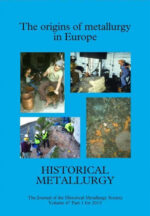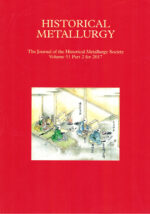Journal Contents
The Oedt sword: a note on brass and fire gilding in the European Bronze Age
Roland Schwab, Frank Wilier, Dietmar Meinel, Michael Schmauder
and Ernst Pernicka
Pages 1-9
The Oedt sword is one of three exceptional but disputed examples of fire-gilded metal objects in Europe dated to the Bronze Age. The sword has been re-investigated to determine its chemical composition and its method of manufacture. Metal analyses and X-ray computer tomography revealed a peculiar construction of the hilt, which is obviously a modem addition to the blade which is most likely of Bronze Age date.
Metallographic investigation and experimental replication of an Etruscan bronze mirror
Paolo Piccardo, Roberta Amendola and Alessandro Ervas
Pages 10-14
The use of copper alloys is known fi’om ancient times and they were appreciated for several reasons: they are easy to cast, have a wide range of mechanical properties and appearance, and goad resistance to corrosion. Most of these properties are affected by composition, and the desired properties could be obtained by the right balance of alloying elements and thermo-mechanical treatment. In particular, to obtain complicated shapes by hammering it was necessary to have a full understanding, perhaps empirical, of how to handle annealing to promote recrystallisation, which depends on both the tin content and the previous deformation of the metal. This study determines the composition and manufacturing process of an Etruscan bronze mirror in order to produce a facsimile.
The possible water-powered bloomery at Goscote (Rushall), Walsall, West Midlands
David Dungworth
Pages 15-20
Bloomery slag deposits at Goscote (Rushall), West Midlands, have been known since the 1960s, corresponding with archive references to late-medieval and 16th-century iron working, the latter probably water powered. Recent sampling has provided slags which can be compared with those examined by Morton and Wingrove. The new samples were made up of one third tap slag, the rest without distinct morphology. Examination indicated the use of coal-measures ore to produce steel rather than iron, but it cannot be proved that the operation was water powered.
Iron in the building of gothic churches: its role, origins and production using evidence from Rouen and Troyes
Maxime L′Héritier, Philippe Dillmann and Paul Benoit
Pages 21-35
Iron was included in the initial design of most gothic churches. Many tons of iron bars were used in stained-glass windows; iron structural rods and chains were used in masoniy and frameworks, and smaller pieces such as cramps and pins were used to attach numerous sculpted ornaments. Many questions arise regarding the use of iron in medieval construction: the quantities used by the master builders, the location, supply and cost, the nature and quality of the ferrous alloys employed and the influence of changes in medieval iron production, notably the introduction of waterpowered hammers and blastfiirnaces. In this research, important medieval churches in Rouen and Troyes were investigated. Medieval account books were studied, and metallographic analyses were carried out on 74 iron pieces sampled in the buildings. This paper presents the methods and the results of this interdisciplinary work.
Identification of a slag-draining bloomery furnace in the Mandara Mountains (Cameroon)
Nicholas David
Pages 36-47
In 1953 Rene Gardi photographed, sketched and briefly described the functioning of bloomery furnaces of the Teleki, a small ethno-linguistic group in the Mandara mountains in North Cameroon. Internal evidence and new data on smelting practices in this region suggest that Gardi’s sketch and description are inaccurate. Using Gardi’s diary, it is argued here that the circumstances of his visit precluded a well-grounded assessment of bloomery techniques, and that Teleki furnaces could not have worked in the way he suggests. Comparative data is presented, gathered among the Bana, who live 20km from the Teleki. These indicate that a previously unrecognized slag-releasing type offiimace was common to both groups. Of the three known montagnardfiirnace types the Teleki-Banan is the most sophisticated—both specialized in the production and export of iron.
Metal to mould: alloy identification in experimental casting moulds using XRF
Thérèse Kearns, Marcos Martinón-Torres and Thilo Rehren
Pages 48-58
Archaeological moulds are often analysed for metal ti-aces to identify the alloys cast in them. However, the relationships between an alloy and its corresponding trace on a mould are not simple, and few studies have investigated them. This paper reports experiments in which copper alloys of known compositions were cast in clay moulds. The moulds were analysed using energy-dispersive X-ray fluorescence to determine the remains different alloys left in them. Some metal oxides mechanically adhere to the mould, but their different thermochemical properties ultimately determine the extent to which they become chemically bonded to the fabric. The metals behave differently in the presence of one another, determining which of the constituents of particular alloys leave traces. Inferences can be made as to the original alloys cast in moulds, but any conclusions should be drawn with caution.






There are no reviews yet.